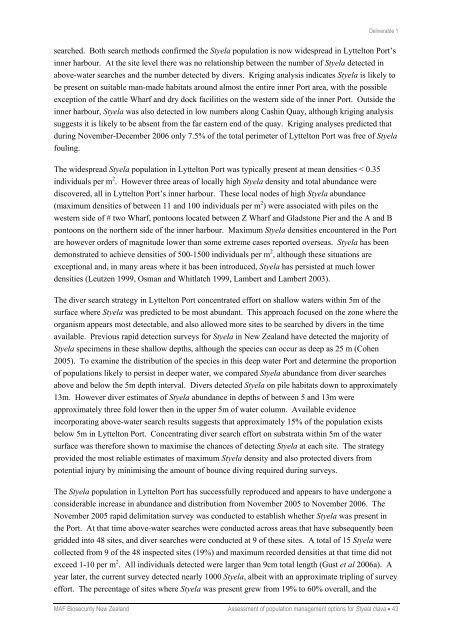Assessment of population management options for Styela clava
Assessment of population management options for Styela clava
Assessment of population management options for Styela clava
You also want an ePaper? Increase the reach of your titles
YUMPU automatically turns print PDFs into web optimized ePapers that Google loves.
Deliverable 1<br />
searched. Both search methods confirmed the <strong>Styela</strong> <strong>population</strong> is now widespread in Lyttelton Port’s<br />
inner harbour. At the site level there was no relationship between the number <strong>of</strong> <strong>Styela</strong> detected in<br />
above-water searches and the number detected by divers. Kriging analysis indicates <strong>Styela</strong> is likely to<br />
be present on suitable man-made habitats around almost the entire inner Port area, with the possible<br />
exception <strong>of</strong> the cattle Wharf and dry dock facilities on the western side <strong>of</strong> the inner Port. Outside the<br />
inner harbour, <strong>Styela</strong> was also detected in low numbers along Cashin Quay, although kriging analysis<br />
suggests it is likely to be absent from the far eastern end <strong>of</strong> the quay. Kriging analyses predicted that<br />
during November-December 2006 only 7.5% <strong>of</strong> the total perimeter <strong>of</strong> Lyttelton Port was free <strong>of</strong> <strong>Styela</strong><br />
fouling.<br />
The widespread <strong>Styela</strong> <strong>population</strong> in Lyttelton Port was typically present at mean densities < 0.35<br />
individuals per m 2 . However three areas <strong>of</strong> locally high <strong>Styela</strong> density and total abundance were<br />
discovered, all in Lyttelton Port’s inner harbour. These local nodes <strong>of</strong> high <strong>Styela</strong> abundance<br />
(maximum densities <strong>of</strong> between 11 and 100 individuals per m 2 ) were associated with piles on the<br />
western side <strong>of</strong> # two Wharf, pontoons located between Z Wharf and Gladstone Pier and the A and B<br />
pontoons on the northern side <strong>of</strong> the inner harbour. Maximum <strong>Styela</strong> densities encountered in the Port<br />
are however orders <strong>of</strong> magnitude lower than some extreme cases reported overseas. <strong>Styela</strong> has been<br />
demonstrated to achieve densities <strong>of</strong> 500-1500 individuals per m 2 , although these situations are<br />
exceptional and, in many areas where it has been introduced, <strong>Styela</strong> has persisted at much lower<br />
densities (Leutzen 1999, Osman and Whitlatch 1999, Lambert and Lambert 2003).<br />
The diver search strategy in Lyttelton Port concentrated ef<strong>for</strong>t on shallow waters within 5m <strong>of</strong> the<br />
surface where <strong>Styela</strong> was predicted to be most abundant. This approach focused on the zone where the<br />
organism appears most detectable, and also allowed more sites to be searched by divers in the time<br />
available. Previous rapid detection surveys <strong>for</strong> <strong>Styela</strong> in New Zealand have detected the majority <strong>of</strong><br />
<strong>Styela</strong> specimens in these shallow depths, although the species can occur as deep as 25 m (Cohen<br />
2005). To examine the distribution <strong>of</strong> the species in this deep water Port and determine the proportion<br />
<strong>of</strong> <strong>population</strong>s likely to persist in deeper water, we compared <strong>Styela</strong> abundance from diver searches<br />
above and below the 5m depth interval. Divers detected <strong>Styela</strong> on pile habitats down to approximately<br />
13m. However diver estimates <strong>of</strong> <strong>Styela</strong> abundance in depths <strong>of</strong> between 5 and 13m were<br />
approximately three fold lower then in the upper 5m <strong>of</strong> water column. Available evidence<br />
incorporating above-water search results suggests that approximately 15% <strong>of</strong> the <strong>population</strong> exists<br />
below 5m in Lyttelton Port. Concentrating diver search ef<strong>for</strong>t on substrata within 5m <strong>of</strong> the water<br />
surface was there<strong>for</strong>e shown to maximise the chances <strong>of</strong> detecting <strong>Styela</strong> at each site. The strategy<br />
provided the most reliable estimates <strong>of</strong> maximum <strong>Styela</strong> density and also protected divers from<br />
potential injury by minimising the amount <strong>of</strong> bounce diving required during surveys.<br />
The <strong>Styela</strong> <strong>population</strong> in Lyttelton Port has successfully reproduced and appears to have undergone a<br />
considerable increase in abundance and distribution from November 2005 to November 2006. The<br />
November 2005 rapid delimitation survey was conducted to establish whether <strong>Styela</strong> was present in<br />
the Port. At that time above-water searches were conducted across areas that have subsequently been<br />
gridded into 48 sites, and diver searches were conducted at 9 <strong>of</strong> these sites. A total <strong>of</strong> 15 <strong>Styela</strong> were<br />
collected from 9 <strong>of</strong> the 48 inspected sites (19%) and maximum recorded densities at that time did not<br />
exceed 1-10 per m 2 . All individuals detected were larger than 9cm total length (Gust et al 2006a). A<br />
year later, the current survey detected nearly 1000 <strong>Styela</strong>, albeit with an approximate tripling <strong>of</strong> survey<br />
ef<strong>for</strong>t. The percentage <strong>of</strong> sites where <strong>Styela</strong> was present grew from 19% to 60% overall, and the<br />
MAF Biosecurity New Zealand <strong>Assessment</strong> <strong>of</strong> <strong>population</strong> <strong>management</strong> <strong>options</strong> <strong>for</strong> <strong>Styela</strong> <strong>clava</strong> • 43
















